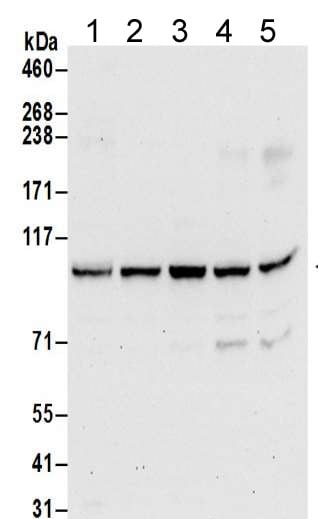Anti-AP2B1 antibody (ab205014)
Key features and details
- Rabbit polyclonal to AP2B1
- Suitable for: WB, IP
- Reacts with: Mouse, Human
- Isotype: IgG
Overview
-
Product name
Anti-AP2B1 antibody
See all AP2B1 primary antibodies -
Description
Rabbit polyclonal to AP2B1 -
Host species
Rabbit -
Tested applications
Suitable for: WB, IPmore details -
Species reactivity
Reacts with: Mouse, Human
Predicted to work with: Rat, Sheep, Rabbit, Horse, Cow, Dog, Pig, Chimpanzee, Cynomolgus monkey, Rhesus monkey, Gorilla, Orangutan
-
Immunogen
Synthetic peptide within Human AP2B1 aa 550-650. The exact immunogen sequence used to generate this antibody is proprietary information. If additional detail on the immunogen is needed to determine the suitability of the antibody for your needs, please contact our Scientific Support team to discuss your requirements. NP_001273.1
Database link: P63010 -
Positive control
- HeLa, 293T, Jurkat, TCMK1 and NIH 3T3 whole cell lysates.
Properties
-
Form
Liquid -
Storage instructions
Shipped at 4°C. Store at +4°C short term (1-2 weeks). Upon delivery aliquot. Store at -20°C long term. Avoid freeze / thaw cycle. -
Storage buffer
pH: 7
Preservative: 0.09% Sodium azide
Constituent: 99% Tris citrate/phosphate
pH 7-8 -
 Concentration information loading...
Concentration information loading... -
Purity
Immunogen affinity purified -
Clonality
Polyclonal -
Isotype
IgG -
Research areas
Images
-
Detection of AP2B1 in Immunoprecipitates of 293T whole cell lysates (1 mg for IP, 20% of IP loaded) using ab205014 at 6 µg/mg lysate for IP (Lane 1). For WB detection ab205014 was used at 1 µg/ml. Lane 2 represents control IgG IP. Detection: Chemiluminescence with an exposure time of 10 seconds. Lysate prepared using NETN lysis buffer.
-
All lanes : Anti-AP2B1 antibody (ab205014) at 0.1 µg/ml
Lane 1 : HeLa whole cell lysate
Lane 2 : 293T whole cell lysate
Lane 3 : Jurkat whole cell lysate
Lane 4 : TCMK1 whole cell lysate
Lane 5 : NIH 3T3 whole cell lysate
Lysates/proteins at 50 µg per lane.
Developed using the ECL technique.
Predicted band size: 105 kDa
Exposure time: 30 secondsLysates prepared using NETN lysis buffer














